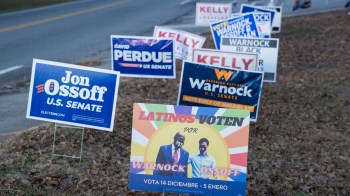Sarah Gardner: From Medicare spending to campaign spending in this very expensive presidential season. $14 million in January alone — that’s how much Mitt Romney’s super PAC “Restore our Future” spent, according to documents filed today with the Federal Elections Commission. Much of it on advertising against his Republican rivals.
Which got us wondering: When you give a dollar to a campaign — let alone millions of dollars — just where does that money go? We asked Marketplace’s Nancy Marshall Genzer to run the numbers.
Nancy Marshall-Genzer: Turns out the presidential candidates leave us a money trail. They’re required to file reports with the Federal Election Commission. Thousands of pages long.
People like Sheila Krumholtz dig through them. She’s head of the Center for Responsive Politics. I paid her a visit recently, and I brought along a blueberry pie. I asked Krumholtz to carve up the pie. It’s a good way to illustrate the numbers.
Sheila Krumholz: Administrative costs, number one, with 44.9 percent. So, let’s see, that’s probably about there, would you say?
Marshall-Genzer: That’s a big piece.
Krumholz: It’s a huge piece.
Why did the candidates spend so much on admin? Well, these are the numbers from 2011, the most recent ones we have. The candidates were just setting up their campaigns — opening new offices, hiring staff, buying lots of pizza, paying consultants. Another reason that category is so big? Krumholz says you can hide stuff in it.
Krumholz: When John Edwards ran and got in trouble for $400 haircuts, that was billed as consulting.
Back to our blueberry pie. The next biggest slice is campaign costs — things like direct mail. Krumholz says media expenses are close behind.
Krumholz: Media is next at 15.5 percent. So far.
This sliver of the pie will definitely get bigger. In fact, it’s usually the biggest slice in an election year.
To dig a little deeper into the media piece, I talked to Ken Goldstein. He’s president of Kantar Media CMAG. Goldstein predicts this year, 45 percent of the money candidates raise will wind up on local TV ads to reach undecided voters.
Ken Goldstein: The undecided eyes are watching “Jeopardy” and “Wheel of Fortune.” And you put ads on “Jeopardy” and “Wheel of Fortune” to get those undecided eyes.
Media expenses can also include print ads and yard signs. Now, there’s another pretty big piece of the pie left. Money spent on raising more money. It’s about 12 percent. Krumholtz carves it out.
Krumholz: So let’s see, what are we talking here? I think that’s about this big.
Marshall-Genzer: Not such a big slice.
Krumholz: Not such a big slice so far.
Yep, Krumholz expects this slice of the pie to get bigger too. But here’s the thing. The fundraising slice is really, really mushy. Say the candidate takes a plane to Miami. He holds a rally, then a fundraiser. So, does the plane expense go under the campaign column? Or fundraising?
Allan Lichtman teaches history at American University, and is a presidential historian.
Allan Lichtman: Expenditures do tend to blur together, particularly fundraising expenditures. And if you’re a smart candidate, everything you do has a fundraising component to it.
So, yeah, it’s a big, runny pie. But the campaign’s expense reports do give us a general sense of where the money’s going. And we’re about to get our first look at the 2012 pie. The candidates have to file their reports for January’s expenses by tonight at midnight, Eastern time.
In Washington, I’m Nancy Marshall-Genzer for Marketplace.
There’s a lot happening in the world. Through it all, Marketplace is here for you.
You rely on Marketplace to break down the world’s events and tell you how it affects you in a fact-based, approachable way. We rely on your financial support to keep making that possible.
Your donation today powers the independent journalism that you rely on. For just $5/month, you can help sustain Marketplace so we can keep reporting on the things that matter to you.


















